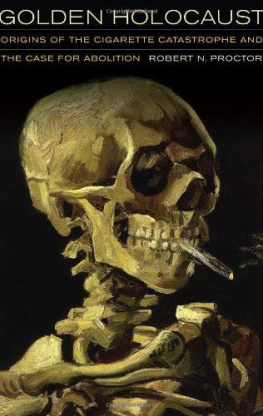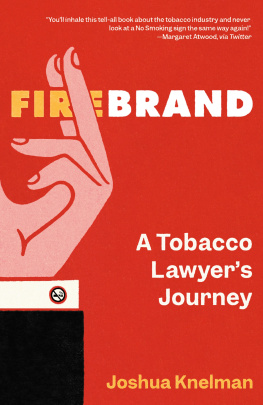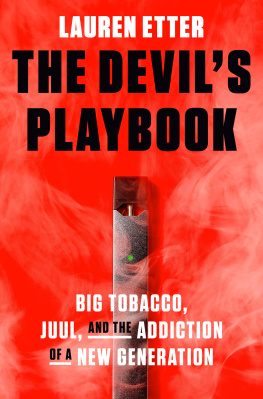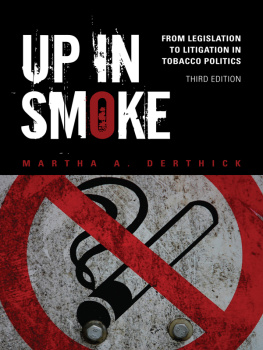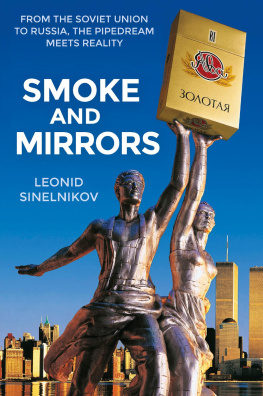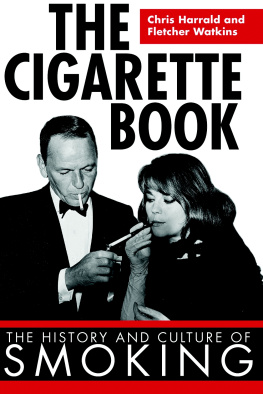ACKNOWLEDGMENTS
I could not have written this book without access to the seventy-plus million pages of documents released by the tobacco industry in response to subpoenas. I would therefore like to thank those many trial attorneys who have fought to bring these racketeers to justice. Lawyers do not always have good reputations, but I have been impressed by the courage and stamina of attorneys fighting the good fight: Madelyn Chaber, Michael V. Ciresi, Richard A. Daynard, Marc Edell, Phil Gerson, C. K. Hoffler, Russell Kinner, Ron Motley, Matthew Myers, William H. Ogle, Gary Paige, Stanley Rosenblatt, Robert Shields, Rod Smith, Mike Withey, and their diligent staffers. These and many others have stood up bravely against one of the worlds most powerful polluters, and in some cases managed to bring them to a modicum of justice. The history of the law firms working on both sides of such trials has yet to be writtenthe industrys side is truly terra incognitaand I look forward to seeing scholars explore this territory.
I am also indebted to those many Herculean scholars who have labored to expose the misdeeds of Big Tobacco. Crucial here, just to name a few, are Mary Assunta, Deborah Barnes, Lisa Bero, Stella Bialous, Alan Blum, Allan Brandt, Simon Chapman, Greg Connolly, Michael Cummings, Rob Cunningham, Stanton Glantz, Norbert Hirschhorn, Richard Hurt, Rob Jackler, Luk Joossens, Matthew Kohrman, Louis Kyriakoudes, Anne Landman, Pamela Ling, Judith Mackay, Ruth Malone, Monique Muggli, Kathryn Mulvey, Naomi Oreskes, Rick Pollay, Channing Robertson, Suzaynn Schick, and Stan Shatenstein. I would also like to thank those precious few industry insiders who, at great risk to themselves, have helped to break the iron chains of secrecy surrounding this business: William Farone, Victor J. DeNoble, Paul C. Mele, James D. Mold, Ian Uydess, Jeffrey Wigand, and Merrell Williams.
Collectively, these right-minded attorneys, scholars, and whistle-blowers have saved many lives. We also are fortunate to have dedicated, policy-oriented bodies like Action on Smoking and Health, the American Legacy Foundation, Americans for Nonsmokers Rights, Doctors Ought to Care, SmokeFreeMovies, the Campaign for Tobacco-Free Kids, the World Congress on Tobacco or Health, and the State of Californias Air Resources Board and Tobacco Control Program, all actively engaged in clean air advocacy. That battle is far from over; there is much to be done. Philanthropic bodies are also starting to make important contributions, notably the Bloomberg Initiative to Reduce Tobacco Use and the Bill and Melinda Gates Foundation. Governments have often been slow to act to reduce the tobacco toll, which is why grassroots efforts are so vital.
The Legacy Tobacco Documents Library represents an unparalleled historical treasure, and one barely probed by historians. I have colleagues who work on slavery; the archives contain over 2,400 documents referencing that topic. I have colleagues who work on China; China appears in over 100,000 documents. Surgeon General appears in 414,000, and cancer in nearly two million documents. And new documentsincluding now some 8,000 videosare constantly being added. Equally important is the opportunity recently opened up to explore the rhetorical microstructure of the archives. Prior to computerization, it would have taken many lifetimes to go through such a large body of documents and gather up all usages of words such as alleged, castoreum, or propaganda. With full text searchability online, howeverthanks to optical character recognitionthis can now be done in a matter of seconds, and by anyone with an Internet connection.
We can only search what has been turned over by the companies, of courseand that limitation is profoundbut the archives do make it harder for ideas once captured to be lost. And optical character recognition works like an enormous magnet, allowing the tiniest of rhetorical needles to be found even in large archival haystacks. History is rendered transparent in ways not previous possible. Many of my colleagues used to labor in secret for the industry, for example, and some presumably still do. The archives make it harder to keep such work secret, however, and therefore facilitate a certain degree of accountability. In the Internet age it is harder to hide in the shadows.
It would be wrong, though, to imagine that the archives have entirely transformed our understanding of Big Tobacco. Observers with keen eyes and a probing mind have long known about the duplicity of the cartel and its desperation to harvest the young. Fritz Lickint recognized this in the 1930s, as did George Seldes in the 1940s, Alton Ochsner in the 1950s, Maurine Neuberger in the 1960s, and legions more from the 1970s onward. Details of the conspiracy even today remain hidden, but that there was such a conspiracy was evident to anyone who compared the industrys propaganda against brute realities. Prior even to the release of the documents, dozens of exposs captured most of the crucial facts: Maurine Neubergers Smoke Screen, Peter Taylors Smoke Ring, Larry C. Whites Merchants of Death, and the many works of Fritz Lickint or Alan Blum or people affiliated with Action on Smoking or Health (ASH) and the like. Subsequent histories have filled in the picture: Stanton Glantzs Cigarette Papers, Richard Klugers Ashes to Ashes, David Kesslers Question of Intent, Allan Brandts Cigarette Century, Simon Chapmans Public Health Advocacy, just to name a few. Crucial here has also been the long-standing web presence of groups like ASH and GLOBALink and the many probing scholarly exposs in journals like Tobacco Control and the American Journal of Public Health.
I probably would not have written this book if three of my four grandparents had not died from smoking: one cancer, one emphysema, one heart attack. Witnessing suffering is often a prompt for seeking answers, if not for finding solace. Most of the people reading this book will have relatives who have succumbed to Lady Nicotine; indeed it is probably the rare person who has not, though they may not know it.
One reason I decided to write this bookabout a decade agowas my surprise to find that many people were swallowing the industrys line that the tobacco problem had been solved. Even worse was this notionspread by cigarette makers themselvesthat the industry had finally come clean, reformed itself, admitted the errors of its ways.
Nothing could be further from the truth. Few people appreciate the scale on which cigarettes are smoked and how shallow are the industrys concessions. It is true that some ground has been concededthat smoking can cause disease, for examplebut the most important facts have never been admitted. We never hear a tobacco manufacturer admit that millions of people die every year from smoking, or that advertising causes people to smoke, or that for fifty-odd years the companies labored night and day to manufacture doubt. Or that young people have been targetedand continue to be targeted. Some of the companies now begrudge that secondhand smoke can kill, but none will admit that the victims number in the tens of thousands per year in the United States alone, with an order of magnitude more worldwide. The industry wont admit that most of the worlds cigarette deaths lie in the future, or that nicotine is as addictive as heroin or cocaine. Or that addiction deeply compromises a smokers freedom of choice. The companies never admit that their best customers come from the least fortunate parts of society, people who are often least able to understand or to escape their addiction. There is no admission that cigarette makers lied for decades about the dangers of smoking and that the deception continues in the form of brands sold as light or mild or their color-coded counterparts. There is no admission that filters are fraudulent, or that the cigarettes sold today are as deadly as any ever sold in the past. History is, in a sense, the industrys worst enemy: they dont want anyone comparing what they now say (and do) to what they so often said (and did) in the past. They dont want to be held accountable. Anyone who thinks there is a new Philip Morris should read a few of the transcripts from any of our recent tobacco and health trials, where blaming the victim is alive and well as a strategy for exculpation.

